Plex: 2 July 2025
Marrakech; Any Which Way; Learning to Use a Flashlight

The Biweekly Plex Dispatch is an inter-community newspaper published by Collective Sense Commons on first and third Wednesdays of each month. Price per issue: 1 USD, or your choice of amount (even zero).
In This Issue
- Marrakech (Kevin Jones)
- Any Which Way (Wendy Elford)
- Learning to Use a Flashlight (Peter Kaminski)
Marrakech
by Kevin Jones
Kevin and Rosa Lee have been traveling in Europe and North Africa for two months. They're now on their way back to the States.

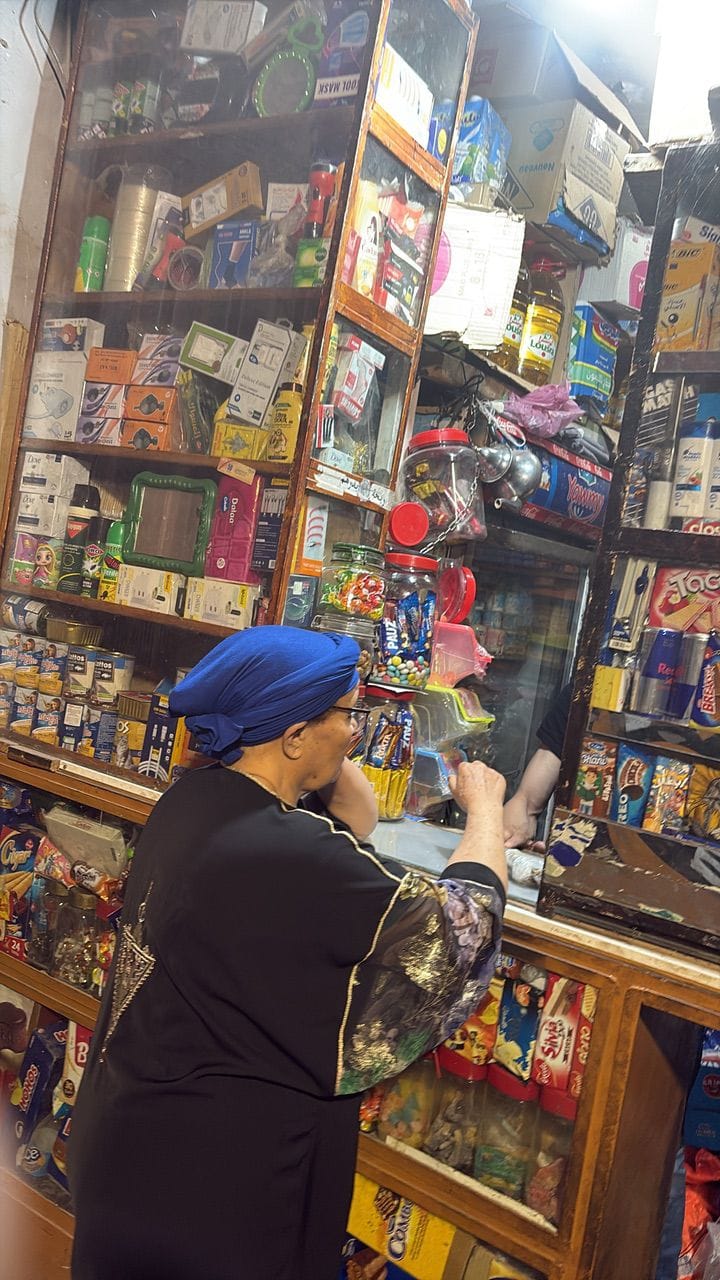

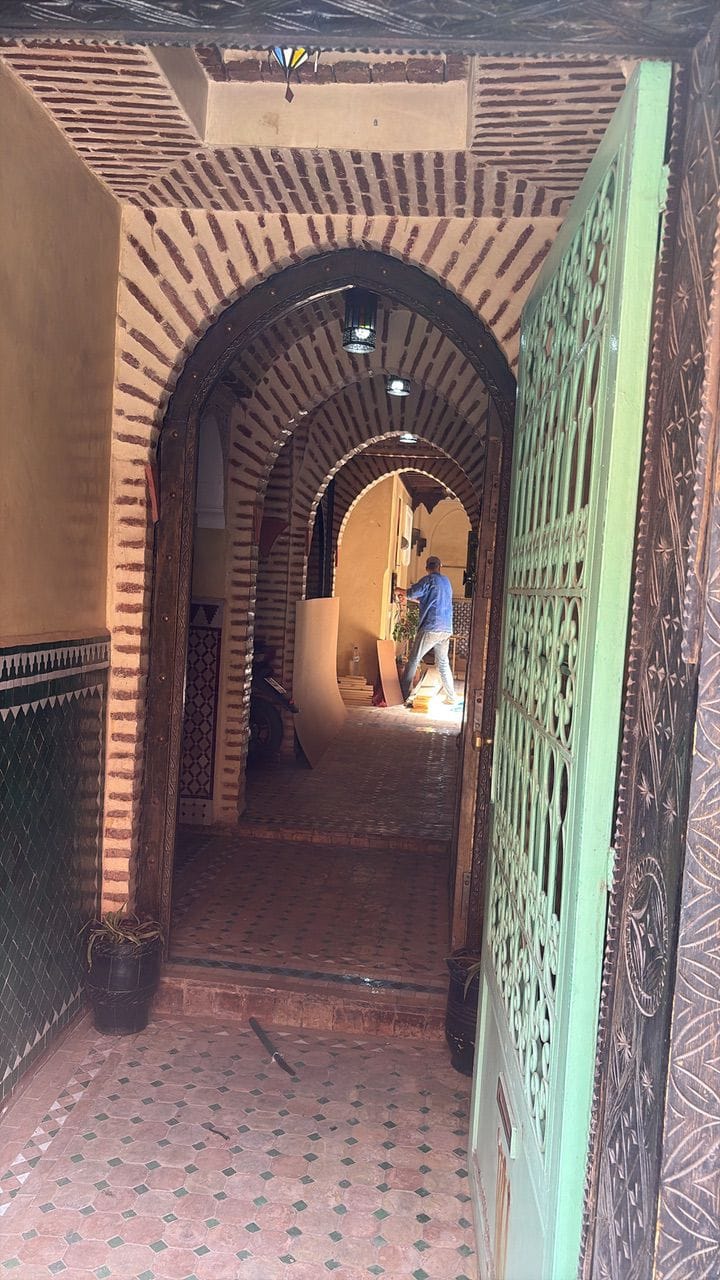




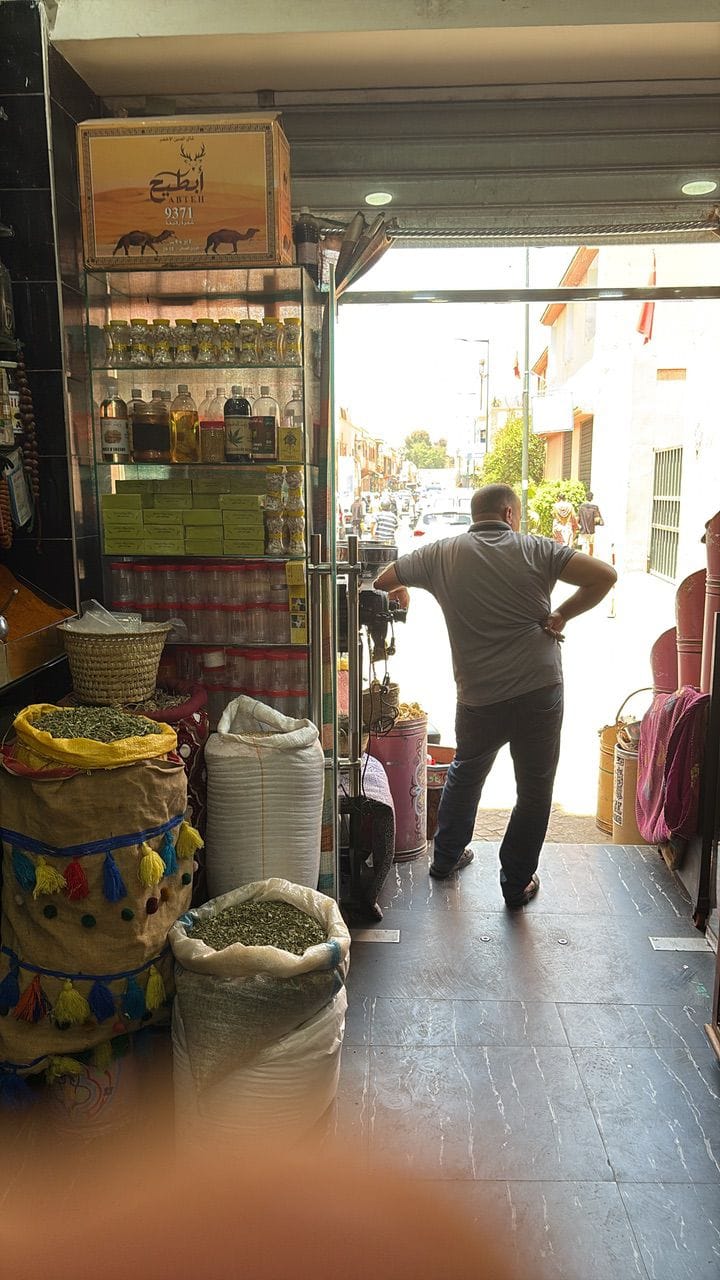
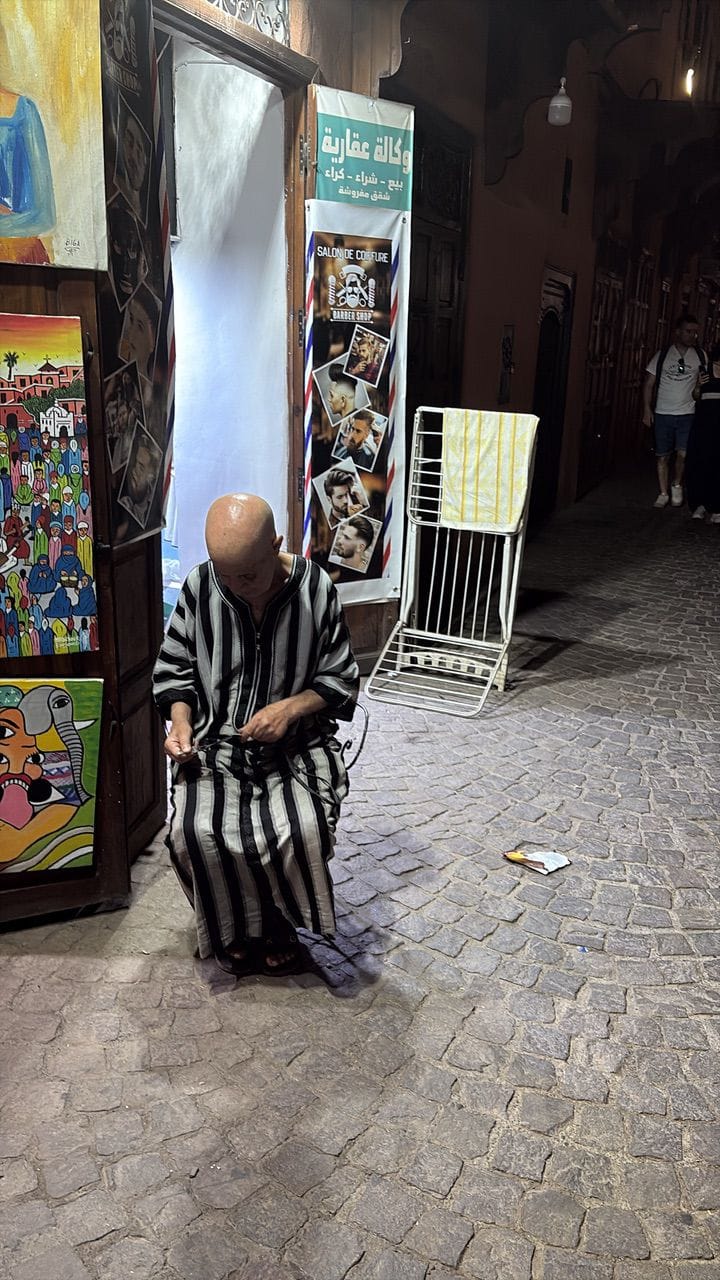
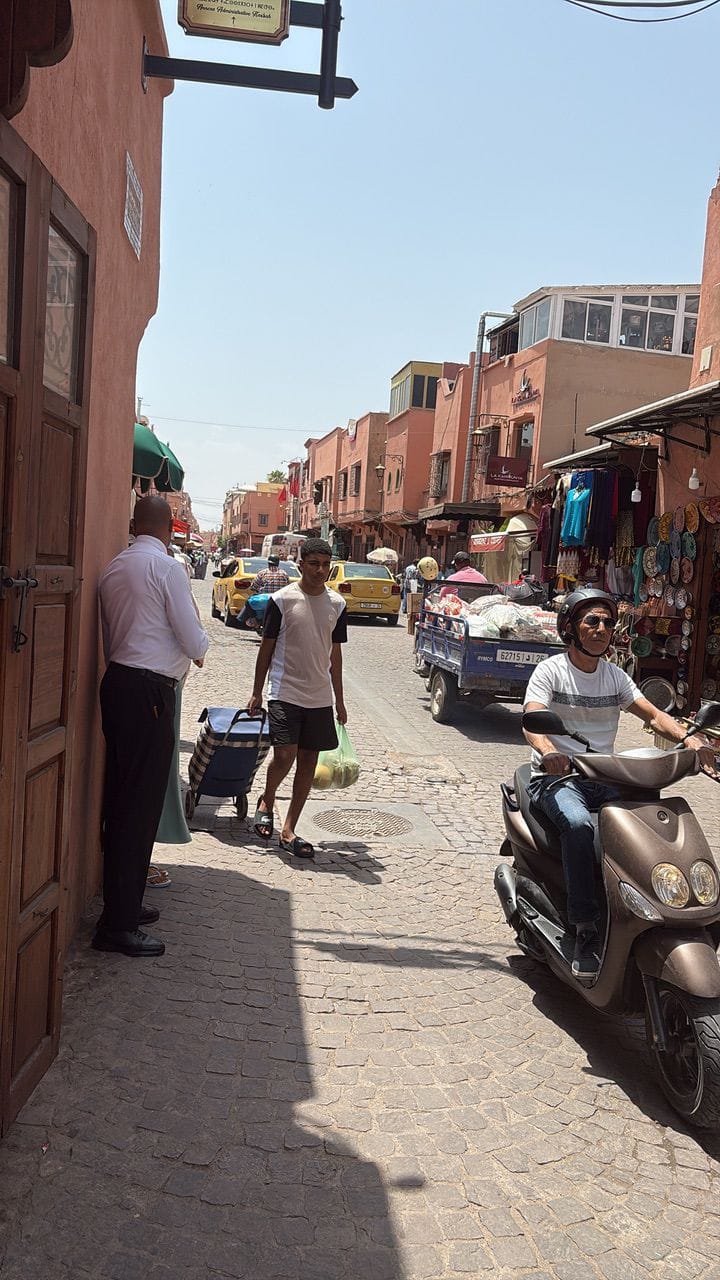

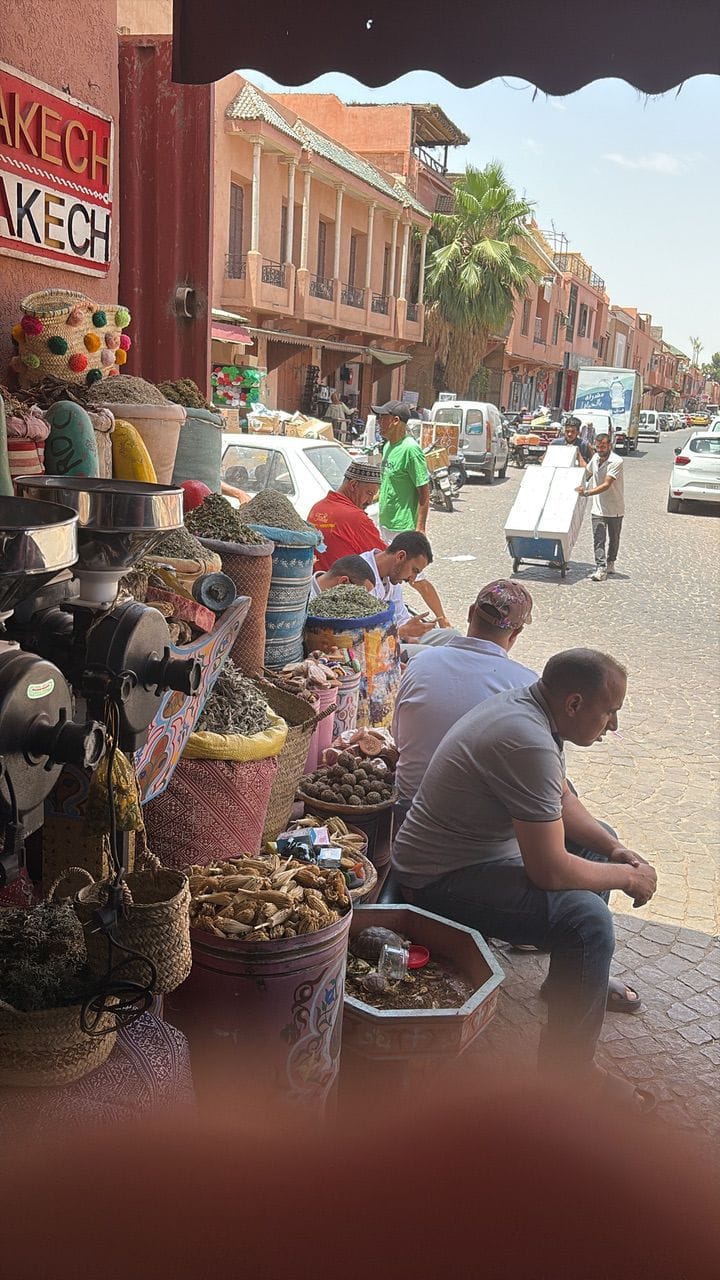
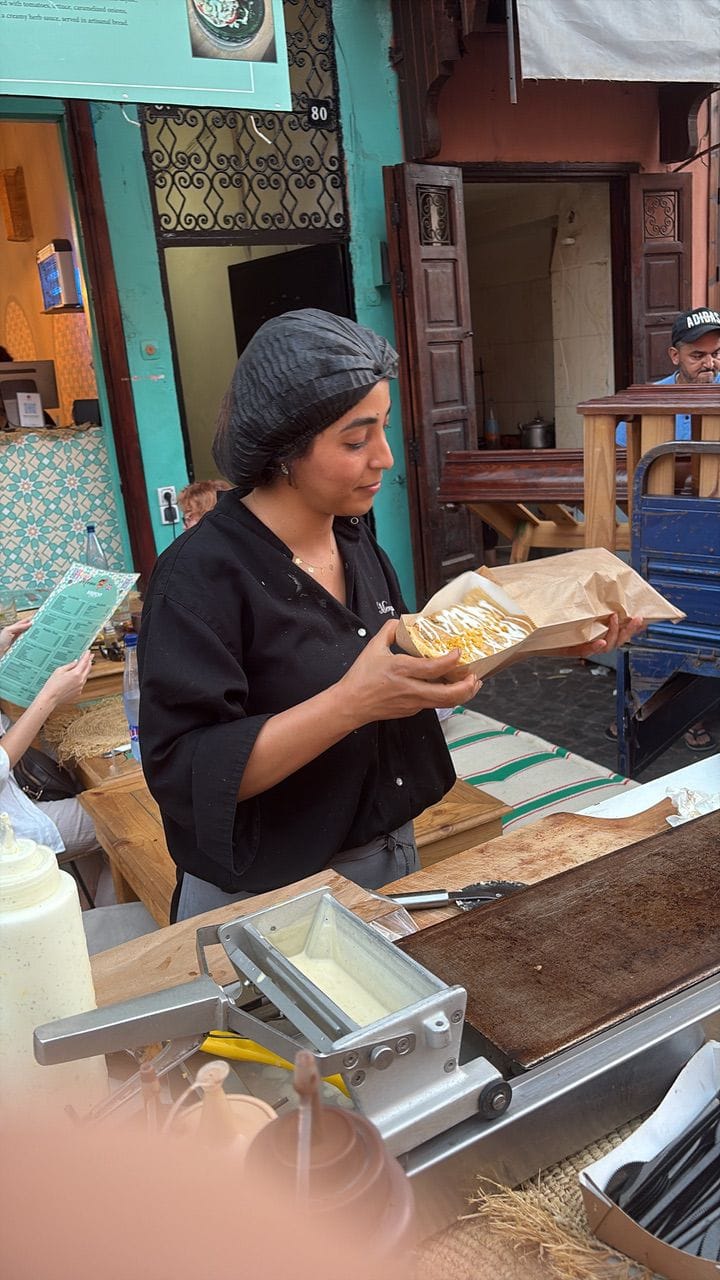

charles blass
Any Which Way
by Wendy Elford
Playing the long game.
There is a phrase - ‘Any which way’ which means there are lots of directions and flows from which something can start, go or stop.
I find it useful in current times which a wise technologist called Venkatesh Rao named ‘The Great Weirding’. This phrase is useful because there are a couple of ways we can deal with the opportunities, requirements and regrets of trying to live a modern and up to date life just now. Any which way reminds me that there are many ways I can get to the end point and some of the ones I have not seen or might not favour can turn out to be the better ones. If there are lots of spinning plates, dropping a couple might also be the better move.
One of the options is to become a little wild witch who I am in my professional world, hence the beginnings of a rebrand included with this shorter post. I’m into the last third of my life give or take some years, so the joke is on me. That is exactly my point. Past Wendy had to do things a certain way, according to the rules. She was quietly a rule breaker. Current Wendy is looking for the best means of elegantly but openly bending but not breaking the rules using a little more forgiveness and authenticity she could have mustered before.
Said another way, there is a call to channel your inner weirdness - for me it is quirkiness - and so become more open to new and possibly intuitive solutions to vexing problems. By not taking things too seriously I get to choose which hill is the one worth dying on and to have a little fun climbing it and enjoying the view.
I am noticing that to play the long game (and this noticing has been obvious to other players), that I need to be more sensitive to the game being played now and to reframe the stories I tell myself about the game that I am playing. Here is just one example based on the idea of trauma informed design. When having renovations done, that really is trauma!
The game scenario is having a brave conversation with the managers of a roof restoration company. Future Wendy does not want a repaint, yet this is possible. Past Wendy would become all high and mighty about the wrongness of a subcontractor (in Australia we call them subbies) NOT sticking to the temperature range suited to painting outdoors. So options are self veiling as the scientist (I’ve done the research and you are wrong), the hapless customer (please help me understand why) and then the negotiator who fixes things. The real way to turn up, the way that worked, was to bring out each of the roles briefly, put them in the box and then get practical. Woosh and the problem goes away. The gone rogue painter now no-longer holds the customer’s emotional state in check mate, but instead the rogue and his over seer have gifted warranties needed for 10 - 15 years worth of peace and security. Being grumpy was never going to be the answer.
An even better way was to audition each of the roles and lightly play the winning one.
Why does this matter? It is the short dip into high friction that wins the long term low friction ease. A game of trust. The tough conversations, biting my tongue then staying curious about what is going on here? Not easy work in the moment when many suppliers are after the shortest route to cash, but much more effective in the longer term.
The long game needs a different set of skills. We may already have these skills. Staying quiet can be one of them, taking a plate away, so to speak. Or letting a plate fall and break then making the obvious observations so we can do a reset. Let the scenery and the props do the work for you. Because we don’t ever really know the what and why behind every single action that other people take. But we sure as hell can tell ourselves a different story which allows a different and hopefully happy ending in this weirdest of times.
A word about an icon
At the moment the game I'd like to play for the rest of this year and into the next is to take myself less seriously. So myself as a joke or myself as a joker. Bringing out the best of our Australian ways I'm ‘having a lend of myself.’ I'm starting to become clear that it doesn't really matter so here goes. In the world of complexity I am playing a cheap trick.
Behind all of this is the reality taking (seriously) that happens when day to day experiencing takes in a big loss in life. My friends will know what that loss is for me. Time to recalibrate, time to reset as my friend said today.
So friends, in the spirit of rebranding, rebirthing and regenerating, I’d like to introduce to you the idea of self veiling. This comes to us from the wonderful James Carse, author of finite and infinite games. And a little icon I have created with a dear tech savvy friend to mark this moment.
Self-veiling is an infinite game we play with ourselves about who we are authentically. We are playful with the veil we throw over body, mind and soul. We temporarily, though often effectively, wear the garb of another self or role. So Dr Wendy Elford has a title. She dons and doffs her academic cap for credibility. She also goes camping and is most at home in the bush around a campfire. But the Wendy who self-veils does not really believe she actually is any of her other roles. She can easily switch between each veil and still authentically be herself. Like the song goes ‘This is me’ from The greatest Showman’. She can’t get stuck.
So I invite you to appreciate the little echidna on a broomstick brandishing a hat and flying somewhere over Australia's red dust into a blue, cloudless sky. My other brand to date has rested on a hard earned doctorate followed by years of wrestling with sensemaking and story making efforts in complex adaptive systems. Irreverently I have called that being a knowledge wrangler. Dr Wendy Elford now has to take a seat while her alter ego, the broom stick wielding echidna aka Dr Wendy Elford (witch) takes to the skies.
You'll see that the echidna is an iconic Australian, a quirky little animal and according to Tyson Yunkaporta, a really quite bright creature. And I can't believe that any echidna has ever had a ride on a broomstick. The echidna is a monotreme or egg laying mammal which forages for ants and is protected by an array of quills. Wendy has also held a private pilots licence and comes from a family of flyers going back to the biplane era.
I am layering one impossibility (broomstick/witchery) with the improbable (quirky Australian Animal) and evoking a layer of mystery and throwing in a doctorate for good measure. I care so much I don’t really care except to be totally authentic and to see where this goes.
So why the echidna? It has been my name in Scouting, the world’s largest youth group, for more than two decades. I have a slightly sharpish personality which my daughter has named as being ‘neuro-spicey’. I am, in short, a divergent.
Why the broomstick? Why the witch? There has been Wendy the good little witch for ages. Wizards and Witches are now out in the world courtesy of Harry Potter’s world wide impact. I failed all the muggles tests in pretty much every job I have ever held and have found I belong with those who practice trick or treat. It’s an important line of praxis between neuroscience, trauma informed and regenerative design and systems thinking. My patience might be tested. I may baulk at answering all your questions - I have a little science and artistry to share, so hence the shortcuts, aka magical thinking. The science is sound.
A lovely bit of ambiguity in the question - Which (witch) is that Wendy? Let’s get her airborne and find out.
Images
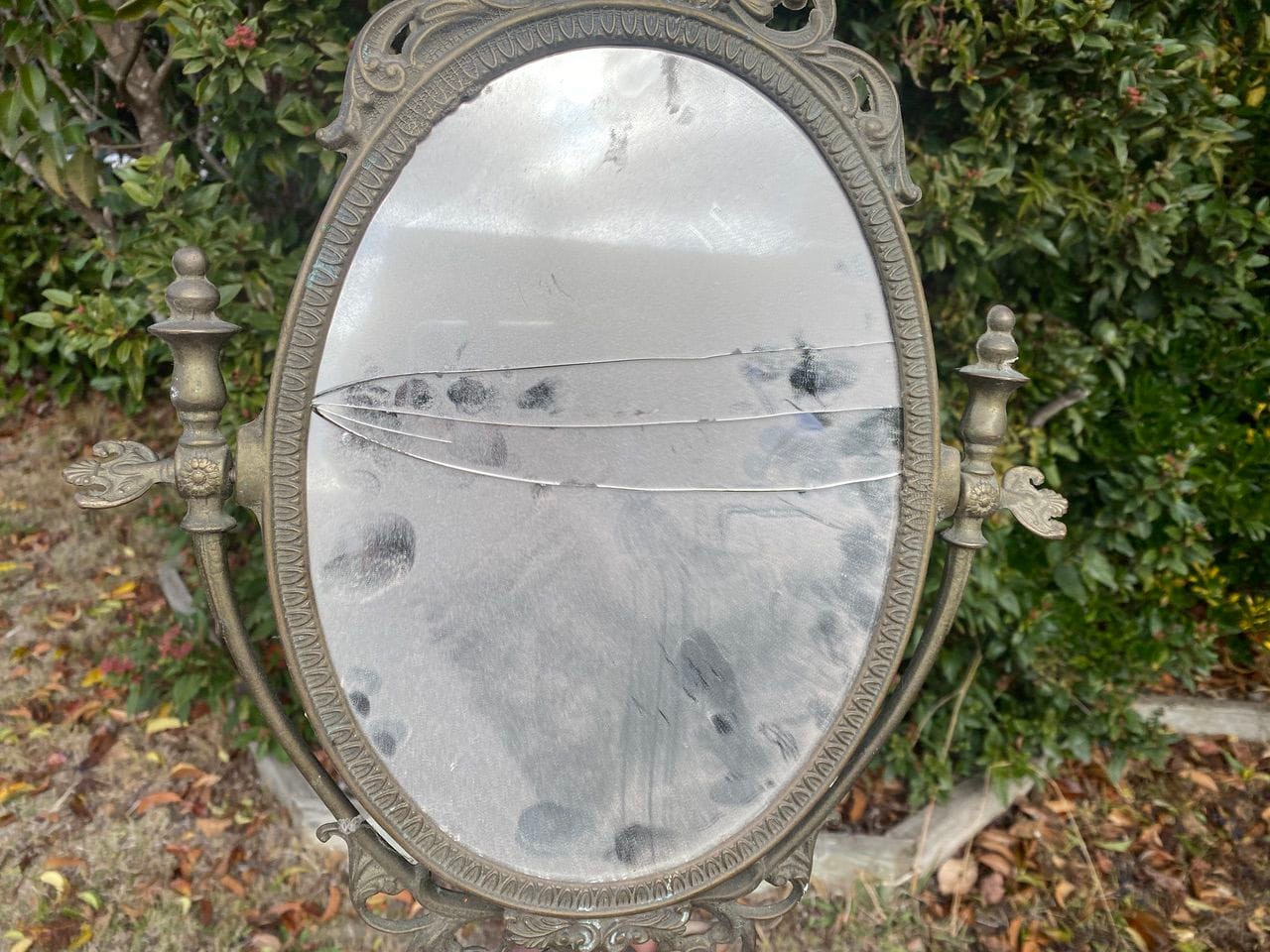
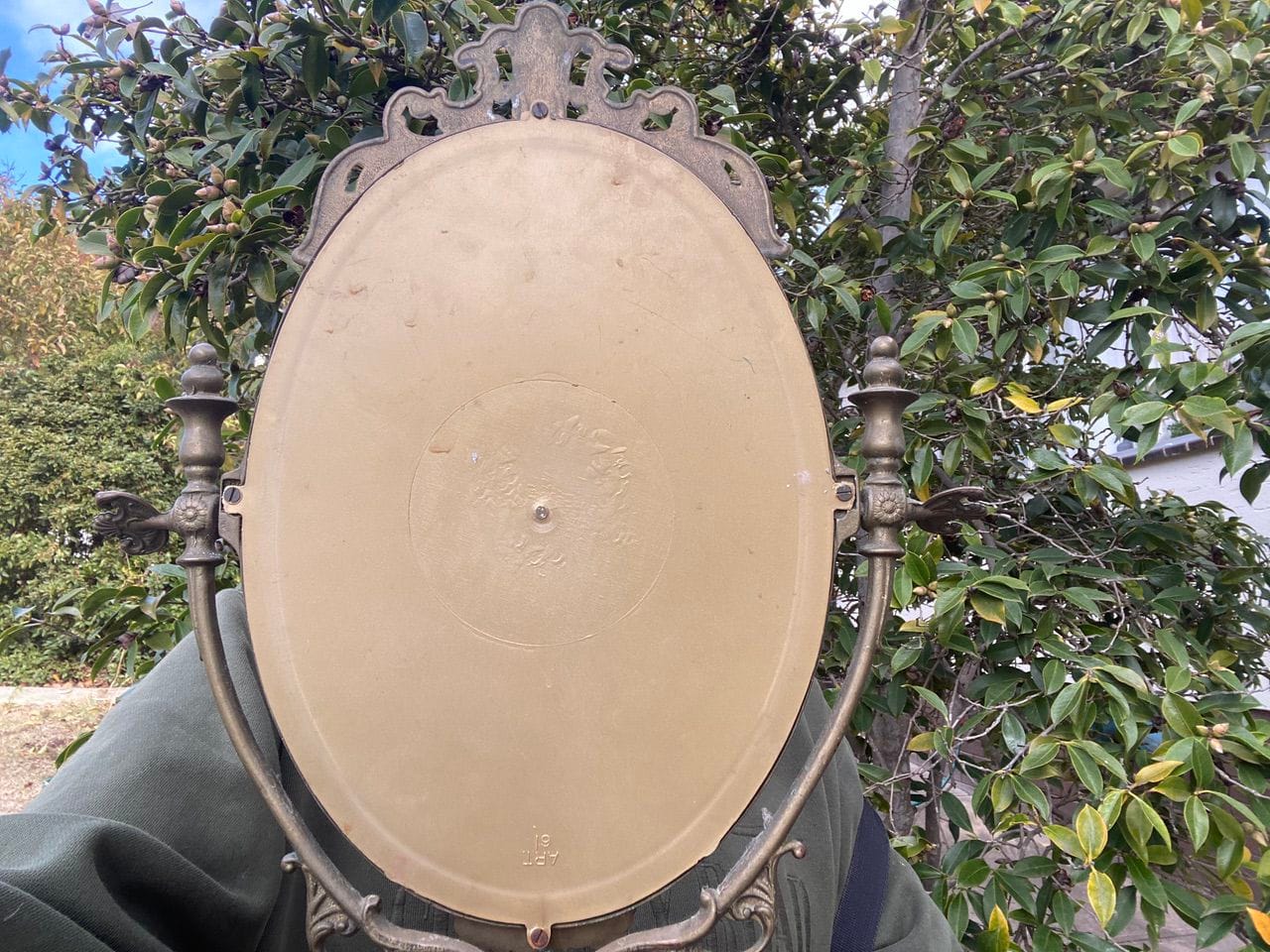
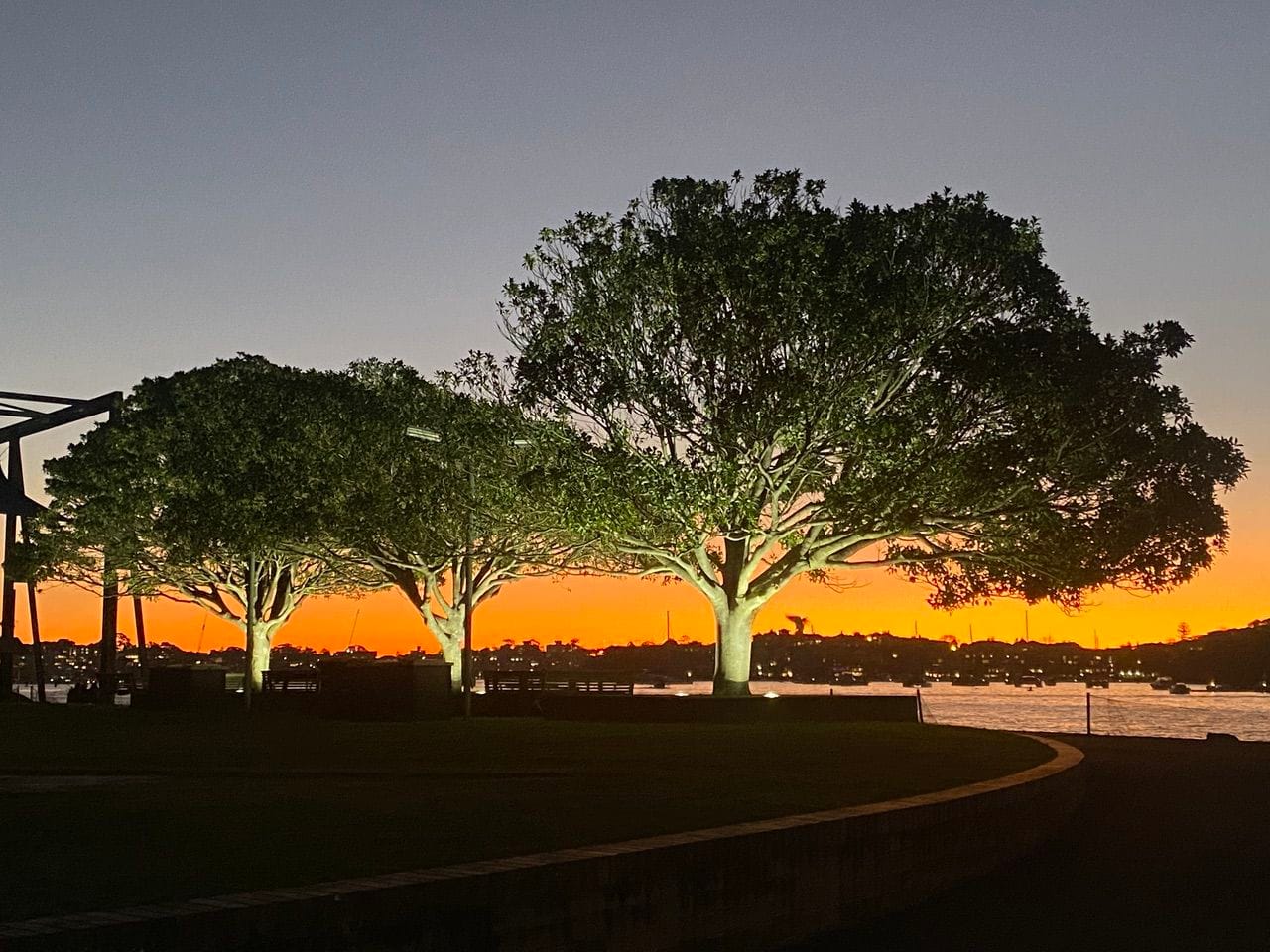


charles blass
Learning to Use a Flashlight
by Peter Kaminski
I like learning curves. There, I said it. You’re probably not surprised if you know me.
I wanted to tell you, I found a new learning curve! In sort of a surprising place: pocket flashlights.
But let’s back up a bit, first.
Growing up in the 1960s and 1970s, tinkering with electrical and electronic circuits was one of my experimental hobbies. And flashlights—or at least, the circuits for them—were pretty much the simplest thing you could build with your toy electrical set. A small incandescent bulb, and two wires, going to each end of a battery. To make it fancy, you could add a switch in the middle of one of the wires, and turn your little “flashlight” on and off. Super fun, not complex at all.
Back then, the biggest, brightest flashlight was for professionals—police officers, construction people working at night, firefighters, farmers. Maglite flashlights, big heavy things, with 2, 3, 4, even 6 “D” batteries. A 4D-cell Maglite with an incandescent bulb would put out 100 lumens—as bright as 100 candles shining all in one place. Fancy ones would have krypton or xenon bulbs, to make them a tad brighter.
Good news for gadget geeks: flashlights have gotten fancy! Any decent flashlight will now put out 100 lumens, and even tiny pocket ones can put out 1,000 lumens or more! Humans perceive brightness roughly logarithmically, so 1,000 lumens looks only 2-4x as bright as 100, but with improvements in batteries, LEDS, and optics, flashlights today are comparatively tiny and last much longer on a charge than the venerable old Maglites.
Interestingly to me, a fancy gadget pocket flashlight is now a little electronic marvel. Even the fanciest ones still look more or less like a Maglite, a metal tube with a bulb on one end and a button somewhere on it, just shrunk down to fit in the palm of your hand.
However, the button is not a physical part of the battery-light circuit anymore. It’s an electronic button that sends a signal to a thumbnail-sized computer, say an ATtiny16 microcontroller or similar, inside the metal tube! The ATtiny16 is roughly 10x more powerful than a first-generation IBM PC. Yikes! If you’re old enough to remember pundits saying there would be computers everywhere, here’s an example.
The software in the flashlight handles the UI (user interface), the operation of the LED(s), tracking the voltage of the battery and the temperature of the flashlight, etc. The first software systems were proprietary to the manufacturer, but lucky for us, a developer named ToyKeeper developed an open source software, Andúril 2, for ATtiny flashlights.
A few years back, I decided to see if I could flip an industry—convert it to free software and get manufacturers to collaborate with the community for mutual benefit. Gotta do something to stay busy, right? The weird thing is, it actually seems to be working. We’ve now got at least ten companies making lights with open-source code, listening to the people instead of treating us as just consumers. It’s a new way of doing business.
(As an aside, Anduril 2 the flashlight software has nothing to do with Palmer Luckey’s Anduril the military technology company, except that their names are inspired by Tolkien’s sword.)
ToyKeeper has a vibrant community helping by using and providing feedback for the software, so the software has grown into a capable and polished flashlight controller, with a finely-tuned UI. And with a number of flashlight manufacturers adopting the software and the UI, it’s become a lovely commons which benefits users and manufacturers alike.
For better or worse, the UI is complicated. Hello, learning curve! There are two main modes, “simple” and “advanced”—but even the simple mode can be a little daunting. Advanced mode is frankly complex.
The complexity is driven by the fact that the only input is a single button, and the only output is the flashlight’s LED(s).
I’ve been really enjoying learning the Anduril UI. Part of it is that it’s learning something in an entirely new realm—clicks and flashes. So not only is it memorizing and committing to muscle memory, it’s in a domain where I haven’t done that before. (I guess something like a Casio watch has some similarities, but Anduril complexity is way above Casio’s, so much that it feels completely new.)
To give you an idea, here are state diagrams that document how to get to different modes and sub-modes. The numbers show how many clicks, while “C” means all clicks, and “H” means hold the last click. So in question and answer posts, you’ll see things like “it’s 3C to get to battery check mode” or “3H to get to the strobe modes, and then 2C to switch between the modes”.
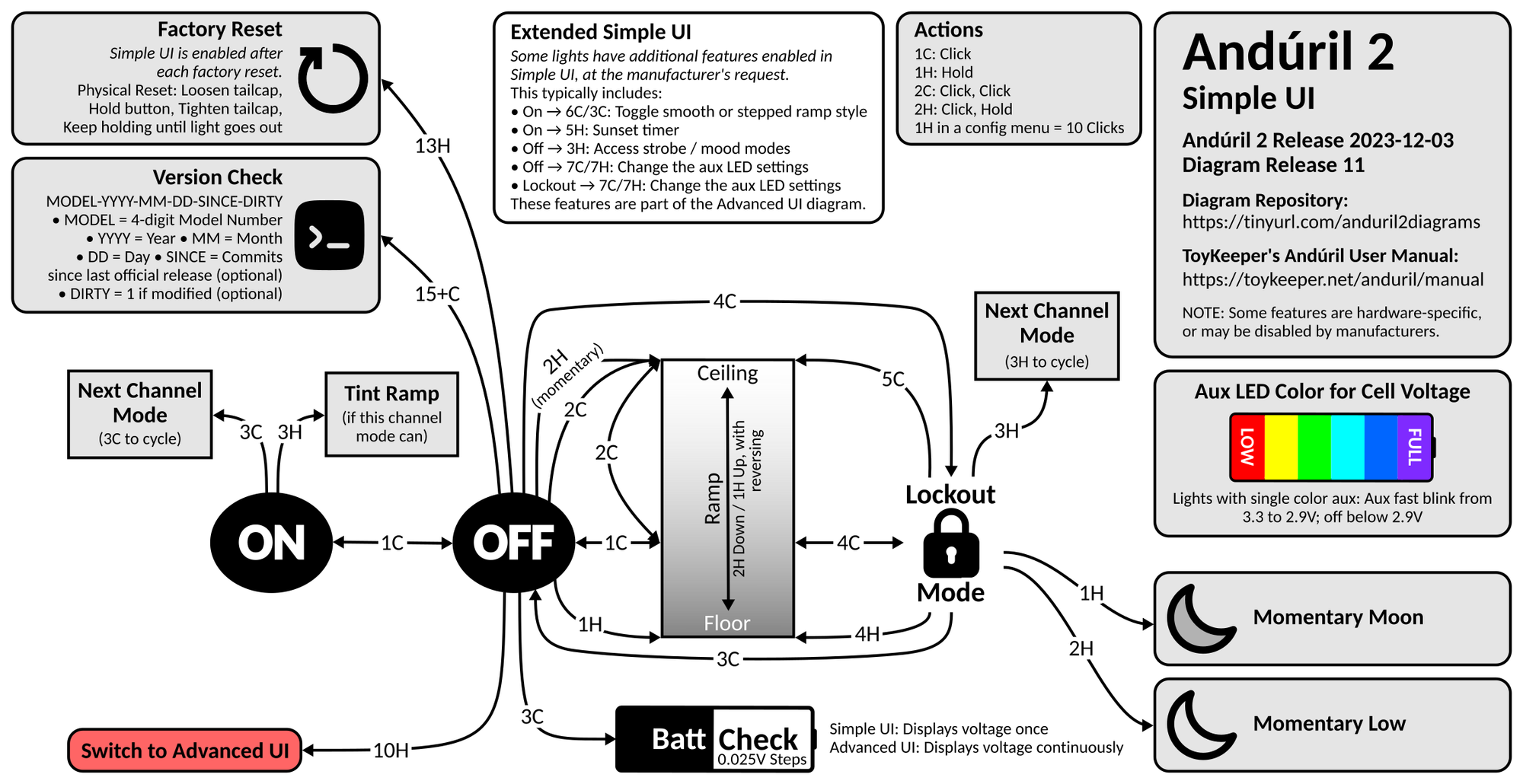
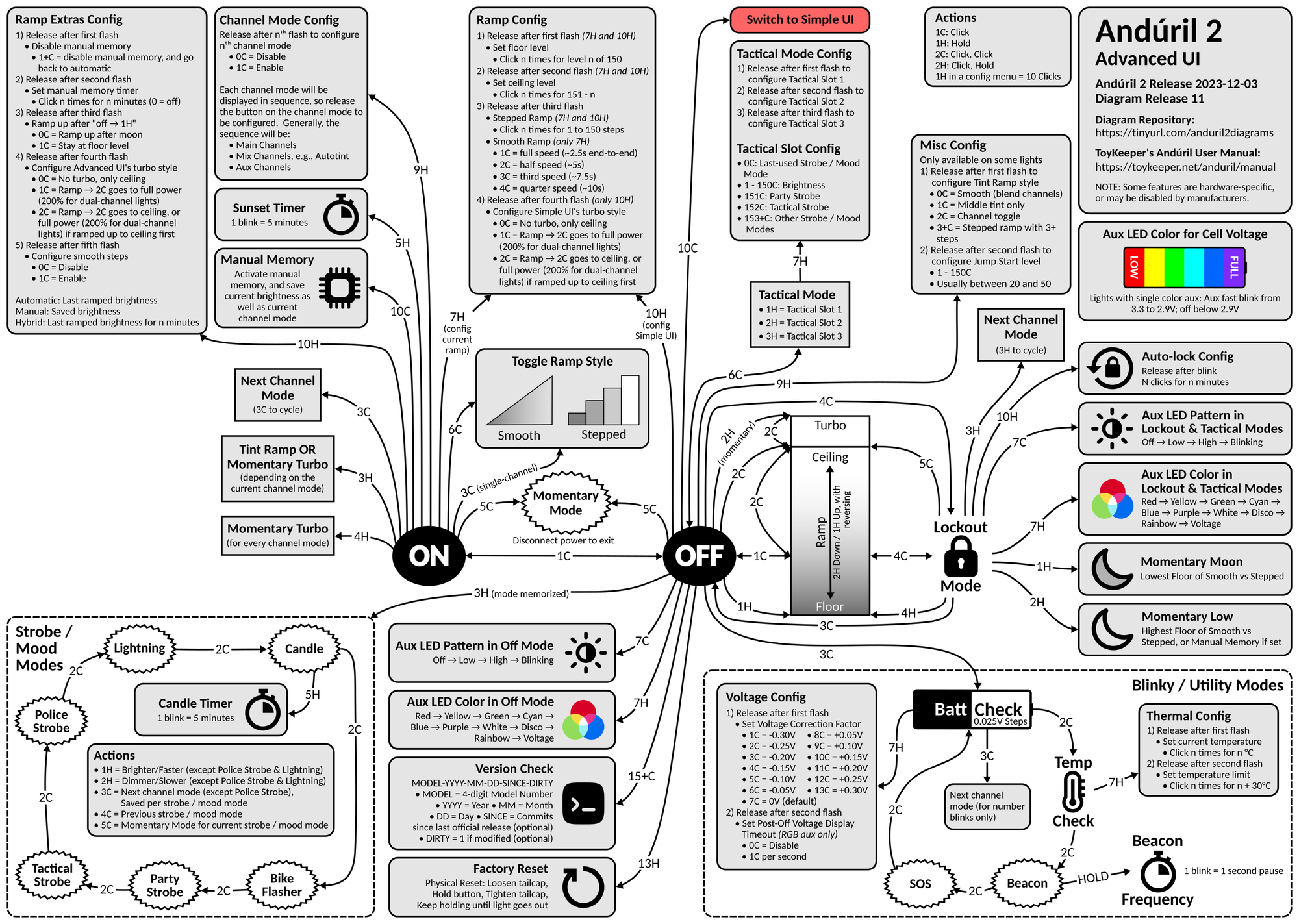
My first Anduril 2 light is the lovely Wurkkos TS10 SG. Some of the things I like about it:
- it’s tiny
- with Anduril, you can configure an incredibly low standby mode
- it’s hard to figure out how to use well—learning curves ftw!
Here are a bunch of random things I’ve learned about the new fancy flashlights:
- they’re fun
- the dramatic difference between a very low floor and very bright ceiling brightness means you’ll temporarily blind yourself if you’re not careful when you’re looking down the barrel of the flashlight
- Claude and ChatGPT can tell you all about the Anduril 2 UI and how to get to different modes (what other “sekrit” stuff do they know about?!?)
- cool kids never have their flashlight all the way off anymore, just in moonlight or standby mode (with weeks of battery life in that mode)
- flashlights are sized to fit the battery they’re built around; a 14500 battery is the same shape as a AA, so it makes a small palm-sized light; an 18650 battery is bigger, and makes a large palm-sized light
- on batteries, the numbers refer to dimensions: 14500 means 14mm diameter x 50mm length, and 18650 means 18mm diameter x 65mm length.
- some 14500 flashlights (but not all) are “dual-fuel”—they can take either a regular AA battery, or a rechargeable and higher-voltage 14500
- good communities of enthusiasts and help: r/flashlight and Budget Light Forum (ToyKeeper’s home turf)
- favorite reviewer: zeroair
- watch for sales, they’re always rotating sale prices
If you’re in the market for a good light, the Wurkkos TS10 SG is a great place to start, if you don’t mind a flashlight that’s hard to figure out. On the other hand, seriously, don’t buy it if you don’t like learning curves.
A more practical beauty is the Olight Baton 4 (with or without the “Premium” charging case). Very solid, high quality light, with a simple, perfect easy-to-use UI.
An honorable mention goes to these sort-of generic clip lights. Their UI is okay, not great, but they’re very practical for dog walking, jogging, or biking.
But not as much fun as an Anduril 2 light! 🙂🔦
Thank you for reading! The next edition will be published on 16 July 2025. Email Pete with suggested submissions.
Grateful appreciation and many thanks to Charles Blass, Wendy Elford, and Kevin Jones for their kind contributions to this issue.